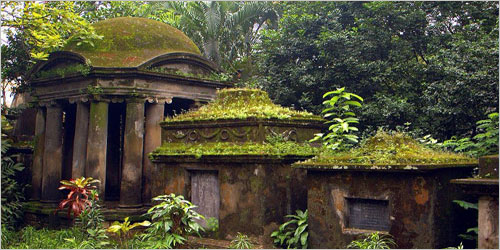“The South Park Street Cemetery (SPSC) is a splendid example of the eclectic tastes of British and Eurasians who were at the helm of affairs in India in the 18th and 19th centuries. The grounds, measuring some eight acres, are enclosed by a high brick wall. Within this, we find an array of 1600 tombs with cenotaphs, tablets and epitaphs, surrounded by a picturesque landscape of tall, shady trees, bushes and plants of many varieties. The tombs, raised on a brick plinth, are mostly of a square, rectangular or circular structure capped by a domical roof and fronted by Corinthian or Ionian columns that support an entablature contained within the pediment. Besides these, there are other types of monuments, including, obelisks, cairns, carved stone urns resting on fluted columns, and the most beautiful sarcophagi. We discern an admixture of the Gothic, and a rich flavour of the Indo-Saracenic style. Of the latter, mention may be made of a unique and composite brick structure built in the ‘panchyatana’ manner, with a central dome flanked by miniature replicas of Orissan ‘rekha deul’ on four sides. Coupled with this peculiarity, the black basalt carvings on the frontal façade indicate a distinct respect for the Hindu faith.
Among the obelisks of various dimensions, one deserves special attention for its soaring height and magnificence. It is dedicated to the mortal remains of Sir William Jones, founder of the Asiatic Society, Calcutta in 1796. Other eminent persons buried here include Henry L V Derozio and Charles (Hindoo) Stuart.
Preservation of such precious heritage sites requires the special expertise of archaeologist-engineers. The structures have to be saved for posterity, without any alteration of their original characters. The right materials and the right workmanship must be selected. Phase I of renovations, completed in 2007 involved the restoration of 15 tombs that needed most urgent attention. Another batch of tombs is being taken up in 2009, even as the surrounding grounds are suitably refurbished in period style, with the added benefit of environment-friendly technology such as solar-powered lighting”.
A K Bandyopadhyay
Advisor - CBB
(Retired Senior Officer, Archaeological Survey of India)
16.03.2009


The Park Street Cemetery, was one of the earliest non-church cemeteries in the world, and probably the largest Christian cemetery outside Europe and America in the 19th century. It still houses the remains of the colonial elite-bureaucrats, military officials, the mercantile big wheels and their families in the glory days of the Raj. As Rudyard Kipling remarked disdainfully in 1891: ‘men were rich in those days and could afford to put a hundred cubic feet of masonry into the grave of even so humble a person as “Jno. Clements, Captain of the Country Service, 1820”.
Others of a more literary bent of mind are amazed that Walter Savage Landor’s “Rose Aylmer” was a real person who lies buried here. As does William Makepiece Thackeray’s father, and one of Charles Dickens’ sons. Not to speak of the pride of Young Bengal, Henry Louis Vivian Derozio, poet extraordinaire and leader of dissidence against all forms of orthodoxy, who took the city by intellectual storm in his brief life of 22 years, and the bicentenary of whose birth is being celebrated on 18 April 2009.
Of course, there could well be some medical grounds for such excessive masonry. From the 18th century onwards, the danger of dead bodies spreading contagious diseases, was a widely known scientific fact. Tropical diseases and fevers, gruesome epidemics from which there was no reprieve…Who knew that death would take away so many? What a price to pay for conquest, we think today. To die on the battlefield may bring a measure of glory; but to be ditched by diarrhoea or malaria or consumption? How tough are the penalties of leadership!
Among the interesting professions mentioned in the epitaphs are: breeder of cattle, jail-keeper, silversmith, school teacher, architect, translator, livery, printer, head tide-waiter, park superintendent, cooper, postmaster, surgeon. All Europeans or their descendants. Were they too out on a ‘civilizing mission’?
What of the countless numbers of women and children? The infants and toddlers, the boys and girls and young women, cut off simply because their destiny was tethered to the men-folk?
“A virtuous mother.”
Died 1825
That is all Grave 363 has to say.
Unobtrusively marking An Unknown Soldier of The Hearth & Home. Did she choose to remain anonymous?
Life expectancy of Europeans during the early colonial period was well under 30 for men; 25 for women. This excludes infant and child mortality, which was unspeakably high. As Theon Wilkinson notes in Two Monsoons (1976): ‘In Calcutta in one year, out of the total 1200, over a third died between August and end of December. It was a regular annual occurrence: the survivors used to hold thanksgiving banquets towards the end of October to celebrate the deliverance.’